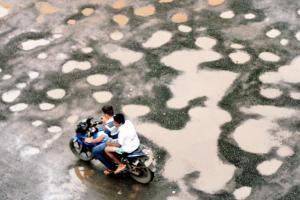Where do potholes come from, and why do they keep reappearing even after the BMC spends crores on repairs every year? Is there a permanent solution? Experts and officials explain it all

Every year, it's the same story. The BMC claims the city's roads are ready for the monsoons, and yet, when the rain falls, potholes appear. Even as people fall into the craters and die, officials at first insist that there are no potholes at all, and then claim that they have already filled all the cavities. Pothole repairs have proved to be nothing but sinkholes for public money. No matter how many times we ask the civic body to repair them, it's like playing whack a mole — another one always appears. Are our roads beyond repairs then? To answer this question, mid-day examines how potholes form and why they keep reappearing.
4,044
No. of potholes in Mumbai in 2017-18
300
Tonnes of cold mix material used so far
10
No. of people who die every day across India due to potholes
Rs 84 lakh
Amount spent on pothole repairs so far this year
Corruption
"There are only two roads that never have any problems — the Sahar elevated road and the Bandra-Worli Sea Link. Clearly, the BMC is capable of making good roads. Even the streets outside ministers' bungalows are smooth, so why do we have to put up with hundreds of potholes?" questioned activist Nicholas Almeida from the Watchdog Foundation. According to him, corruption is the number one cause for our pockmarked roads. Case in point: the R2,000-crore road scam that exposed the nexus of contractors and civic officials. "Such crucial proposals have been passed by officials in a matter of five minutes. They're just interested in their cut," he alleged.
Why potholes appear
Vinod Chithore, chief engineer of BMC's Roads and Traffic Department, said, "The main reason for potholes is haphazard trenching. There are more than 30 utility agencies digging up roads." While the BMC may blame other agencies, it is a combination of poor drainage, materials and maintenance that is at fault. S R Tambe, member of the Standing Technical Advisory Committee (STAC) on roads, explained, "In a city like Mumbai, the waterproofing layer on top of asphalt roads gets worn out and rainwater starts seeping into the foundation, weakening it. Hence, it needs a new coat about every three years. Secondly, the drainage is poor due to low altitude in most parts and proximity to the sea, and it often gets clogged. If the base is waterlogged, it will give way."
They keep coming back
There is a right way to fill potholes. Tambe, a member of STAC, which wrote the manual on the proper method, said, "When you see a pothole of irregular shape, you have to first cut it into a rectangle or square, removing the weakened edges of the pothole and any loose material in it. Ideally, the pit should be dry before you fill the repair mix and then compact it well. The road should only be opened for use after a few hours, when the mix has dried and set and gained strength." But no matter how cold mix the BMC uses to fill the potholes, they simply reappear. Chithore explained, "The potholes are repaired on surface, but there are persistent pipe leakages that cause potholes again. Also, we don't get enough curing time after filling potholes, as we have to start the traffic immediately."
For concrete results...
Mumbai faces a unique challenge when it comes to roads, because most of the city is just reclaimed land between the original seven islands. "The water level is not too deep in this city, and when the subsoil is soaked, the foundation under the roads is compromised," warned Tambe. One solution is to convert all major roads from asphalt to concrete. Take a look at Juhu circle; it used to be notorious for potholes, but even since it was concretised, the road quality has improved vastly. "But it is expensive and not easy. Once a concrete road is laid, you cannot allow traffic on it for 20 days," said Tambe. Chithore added, "We have concretised more than 650 km of road, and will do more. However, considering utility issues, only roads wider than 13.4 m can be concretised."
Supreme Court wants answers
On July 20, the Supreme Court observed that the pothole crisis had become "frightening", stating: "Reports say that more people have died due to accident caused by potholes than the deaths in terrorists attacks." The road safety committee now has until next week to submit a report on the issue.
For the record
Navin Lade, member of the Republican Party of India (RPI), has applied to the Guinness World Records to recognise Mumbai as the city with most potholes.
Catch up on all the latest Crime, National, International and Hatke news here. Also download the new mid-day Android and iOS apps to get latest updates
 Subscribe today by clicking the link and stay updated with the latest news!" Click here!
Subscribe today by clicking the link and stay updated with the latest news!" Click here!









